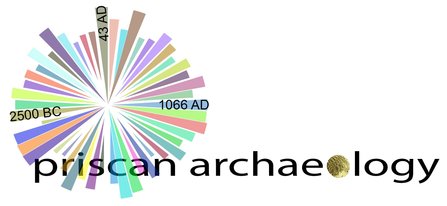Priscan Archaeology Milestones
April 2011 The initial journey begins with the testing of a new type of metal-detector and the unearthing of the badge of St Ursula.
January 2013 The start of our initial three year journey with the challenge of acquiring crucial key permissions that may be instrumental in the recovery of the widest range of ancient British history within that time frame.
July 1st 2013 A film crew with director Samuel Palmer arrived at the Museum of Lancashire to film the background to St Ursula and the significance of the badge with Mariella Frostrup.
After that, a second section was filmed at our home with the conclusion being filmed in Cologne.
This section of the story in Cologne was again with Mariella Frostrup, amazed at the sight of the collection of hundreds of human bones at the Basilica of St Ursula.
The fascinating video can be seen here.
December 2013 saw Robert Hamer joining the team who, with his meticulous search methodology and enthusiasm, enhances our systematic, dynamic and professional approach to artefact recovery and recording.
June 2014 saw the launch date of our website; Priscan Archaeology.
The website will evolve over time, embracing important changes in current technique and technology.
March 2015 saw the trial launch of our "live" survey feed on Twitter capturing exciting recoveries as they happen including 'in situ' images where possible.
February 2017 begins with the second phase of our journey to strengthen our key permissions with the addition of possible new sites and recoveries.
28th May 2017 saw the welcome addition of Robin Siddle to the team and brings with him a wealth of specific knowledge and experience that will enhance our drive to achieve our aims.
June 2017 was also a month that saw some cosmetic changes to the website, creating a fresh new look.
August 2017 The installation of our first bespoke display cabinet at one of our major sites. The cabinet is hand-made by a master craftsman in English Oak and filled with recoveries from the Estate.
August 2017 Our first major excavation on one of our premiere sites consisting of three 2 x 10 mtr trenches over a week long period investigating the history there. Part of a deserted Medieval village was uncovered with several pieces of pottery recovered along with building debris dating C13th to C16th.
November 2017
Photogrammetry (3D objects from 2D photos) was tried out for the first time with mixed results. This could be a new way of displaying finds and perhaps helping with identification too.
Examples of our initial attempts can be seen here.
February 2018
- The quest for photogrammetry excellence continues with further examples added to the Sketchfab site.
- We are honoured to have been asked to choose the location of the third trench of one of the three 10 x 10 mtr trenches that are going to be situated on this years annual dig at one of our top sites this August.
- Tickets are booked to join up with several members of the original Time Team crew in September.
August 2018
The second annual excavation at our main site in Yorkshire. The dig concentrated on a new area where several Roman denarii and sherds of Roman pottery was picked up on one of our initial surveys.
The remains of a Roman villa were discovered with the possibility that the site is pre-Roman.
October 2018
The British Museum noted that we had recovered a Roman denarius of Commodus that wasn't currently in their collection. The BM asked if we were in a position to donate it, of which we of course obliged on the 19th October and they humbly christened it with an aqusition number.
Coin detail: <click for link>
August 2019
The third annual dig took palce at another site on the farm where several Roman coins, pottery and tasserae had been recovered during our initial surveys.
This proved to be yet another Roman villa, this time with hypercaust tiles being unearthed.
More artefacts were recovered including Samian Ware, coins and a lovely bone hairpin.
August 2020
The fourth annual dig at our premiere site was planned to cover 7 days but alas, at least 3-days were lost to inclement weather. This, along with the current Covid-19 pandemic certainly put a dampener on things.
August 2020 to April 2021
This was probably our worst season to date with a mixture of Covid-19, inclement weather and a few other challenges thrown into the mix stopping us from getting out there!
August 2021
The fifth annual dig is scheduled to take place over a two-week period.
Yet more the Roman 'Mansio' was revealed with more possible burials and rooms being revealed.
January 2022
Although we have had another bad season, we managed to recover a find which is perhaps one of our best finds to date with the recovery of an Anglo-Saxon gold aestel.
August 2022
DigVentures return for a sixth season exploring our Roman site with perhaps the final excavation at the 'Mansio' site.
The Whole of 2023
2023 was another poor year for us outing wise with only eleven surveys.
DigVentures excavated in a new field for 2023 with a crouch burial and many artefacts recovered.
However, we had a great year with regards to the amount of Anglo-Saxon coinage we recovered, both on our sites and at the dig on Lindisfarne.
Results for the eleven outings can be seen on our Flickr site.
2024
